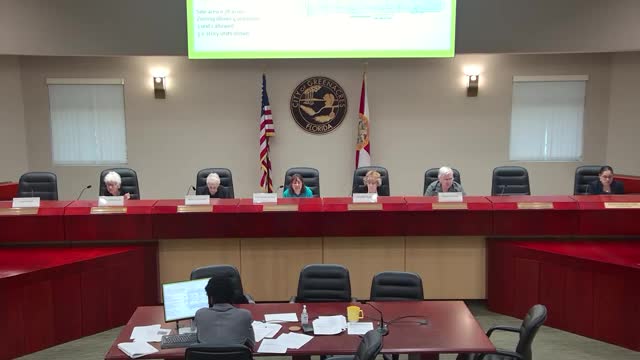Controversy Erupts Over New Townhouse Development Plans
August 09, 2024 | Greenacres, Palm Beach County, Florida

This article was created by AI summarizing key points discussed. AI makes mistakes, so for full details and context, please refer to the video of the full meeting. Please report any errors so we can fix them. Report an error »

In a recent government meeting, discussions centered around a proposed mixed-use development featuring three two-story townhomes and office space on a 0.78-acre site. The project, which is subject to zoning regulations allowing four units per acre, has raised concerns regarding parking, easements, and community impact.
The development plan includes a total of 20 parking spaces, exceeding the 19 spaces recommended by a parking study. This study accounted for the fluctuating needs of both residential and office users, suggesting that the parking requirements could be met effectively. Each of the three-bedroom townhomes will have designated parking, with additional guest spaces available.
Access to the site has been carefully planned in collaboration with county officials to ensure traffic flow is efficient. A single driveway will serve both the townhomes and the office space, strategically positioned opposite a neighboring driveway to minimize congestion.
However, the project has faced scrutiny from local residents. Ruben Soto, a nearby homeowner, expressed his concerns during the public hearing segment of the meeting. Soto, a Vietnam veteran, voiced apprehension about the potential increase in traffic and the impact on his property, which he has owned since 1998. He questioned whether adequate measures, such as fencing, would be implemented to separate the new development from his home, emphasizing his desire for privacy and minimal disruption.
The meeting also addressed the challenges posed by existing easements on the property, which occupy nearly 40% of the site. These easements restrict landscaping options and complicate the development layout. The project team has proposed a landscape plan that includes a variety of trees to enhance the green space, aligning with the city’s vision for a verdant community.
Additionally, the development will feature a small pavilion for outdoor activities, contributing to the livability of the area. The architectural design aims to incorporate natural materials and biophilic elements, promoting a harmonious relationship with the environment.
As the meeting concluded, the board members prepared to vote on the necessary variances for the project, which will determine the future of this mixed-use development and its integration into the existing neighborhood. The outcome will be closely watched by both supporters and opponents, as it reflects broader themes of urban development, community engagement, and the balance between growth and residential quality of life.
The development plan includes a total of 20 parking spaces, exceeding the 19 spaces recommended by a parking study. This study accounted for the fluctuating needs of both residential and office users, suggesting that the parking requirements could be met effectively. Each of the three-bedroom townhomes will have designated parking, with additional guest spaces available.
Access to the site has been carefully planned in collaboration with county officials to ensure traffic flow is efficient. A single driveway will serve both the townhomes and the office space, strategically positioned opposite a neighboring driveway to minimize congestion.
However, the project has faced scrutiny from local residents. Ruben Soto, a nearby homeowner, expressed his concerns during the public hearing segment of the meeting. Soto, a Vietnam veteran, voiced apprehension about the potential increase in traffic and the impact on his property, which he has owned since 1998. He questioned whether adequate measures, such as fencing, would be implemented to separate the new development from his home, emphasizing his desire for privacy and minimal disruption.
The meeting also addressed the challenges posed by existing easements on the property, which occupy nearly 40% of the site. These easements restrict landscaping options and complicate the development layout. The project team has proposed a landscape plan that includes a variety of trees to enhance the green space, aligning with the city’s vision for a verdant community.
Additionally, the development will feature a small pavilion for outdoor activities, contributing to the livability of the area. The architectural design aims to incorporate natural materials and biophilic elements, promoting a harmonious relationship with the environment.
As the meeting concluded, the board members prepared to vote on the necessary variances for the project, which will determine the future of this mixed-use development and its integration into the existing neighborhood. The outcome will be closely watched by both supporters and opponents, as it reflects broader themes of urban development, community engagement, and the balance between growth and residential quality of life.
View full meeting
This article is based on a recent meeting—watch the full video and explore the complete transcript for deeper insights into the discussion.
View full meeting